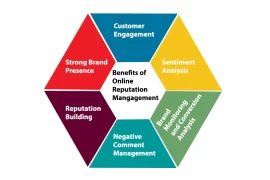The term “brand reputation monitoring” refers to the process of following and managing the perception and sentiment surrounding your brand or company across a variety of internet platforms. This can be done to protect and enhance your reputation. Monitoring online conversations, mentions, reviews, and comments allows you to acquire insights into how your brand is perceived and proactively handle any problems or opportunities that may arise as a result of this. The following is a guide to monitoring the reputation of brands:
Establish Objectives for Yourself.
Establish your goals for the monitoring of the reputation of your brand. Determine whatever components of your brand, such as consumer sentiment, reviews, mentions in social media, or industry debates, you wish to keep an eye on and then monitor.
Monitor Social Media
Always be on the lookout for mentions of your company, its products, or its services on social media channels. Make use of social listening technologies in order to monitor conversations, hashtags, and keywords related to your business. Pay close attention not just to the direct mentions but also the indirect connections.
Keep an eye on the review sites.
Always make it a habit to monitor review platforms, such as Yelp and Google My Business, as well as industry-specific websites, for feedback and ratings provided by customers. It is important to respond to both positive and negative feedback in a timely and professional manner.
Follow the blogs and online news outlets.
Keep a watch out for mentions of your business in various venues, including blog posts, news stories, and industry magazines. Make use of Google Alerts or one of the many other tools available for media monitoring in order to be notified whenever your brand is referenced.
Keep an eye on various online communities and discussion boards.
Locate online communities, discussion boards, and forums that are pertinent to your sector or specialization that you may participate in. Always keep an eye out for conversations and mentions of your company on these channels. When it is permissible to do so, engage in behavior that is both helpful and unpromotional.
Keep an eye on the results of search engines.
Conduct consistent searches on search engines using your brand name and other relevant keywords. Pay close attention to the search results, which may include knowledge panels, featured snippets, and related searches. Take action in response to any information that is unfavorable or misleading and appears in the search results.
Maintain a Record of Mentions of Competitors
Listen in on the conversations and remarks that are taking place online about your rivals. Gain an understanding of how your brand stacks up against those of your competitors and locate areas in which there may be room for development.
Make Use Of Tools For Monitoring Brands
Utilize brand monitoring tools and software to automate the process and collect information from a wide range of sources. Brand24, Mention, Hootsuite, Google Alerts, and other social media listening services are just some of the popular solutions that are available.
Analyze Sentiment
Conduct an analysis of the feelings that are evoked by references of your brand. Establish whether the attitude is one of positivity, pessimism, or neutrality. Find recurrent themes or problems that you can either solve or use to your advantage in developing your brand strategy.
Participate and provide your input.
Maintain a conversation with your readers and always respond to mentions in a timely and appropriate manner. Acceptance of positive input, addressing concerns, and the provision of solutions in response to negative feedback should all be made. Demonstrate gratitude for the continued support of your customers and address any concerns they may have in an open and compassionate manner.
Maintain a Close Eye on Employee Behavior
Maintain vigilance on the manner in which your staff represent your business online. Instruct them on the significance of preserving a positive image for the brand, and provide them guidance on how to behave appropriately when using the internet.
Continue to be proactive.
Maintain a vigilant vigilance over your brand’s online presence at all times and take preventative measures to resolve any possible reputational threats. In order to adapt your strategy for managing the reputation of your brand to the ever-changing environment, routinely examine and update it.
Gain Knowledge through Criticism
Make use of the information gathered from monitoring your brand’s reputation to improve your products, services, and the entire experience you provide for your customers. Determine patterns and areas of weakness based on the comments and suggestions of customers, then make any necessary adjustments.
Online Crisis Management
Create a detailed action plan and strategy for responding in the case of a crisis involving the reputation of your brand. It is imperative that prompt, open, and genuine action be taken in order to minimize any possible harm and restore trust.
Conclusion
Keep in mind that monitoring the reputation of a brand is a continuous activity that calls for persistent attention and action. Maintaining a positive brand image, addressing issues raised by customers, and capitalizing on chances for development and improvement are all things that are possible when you regularly monitor and manage the online reputation of your business.

Leave a Reply Cancel reply